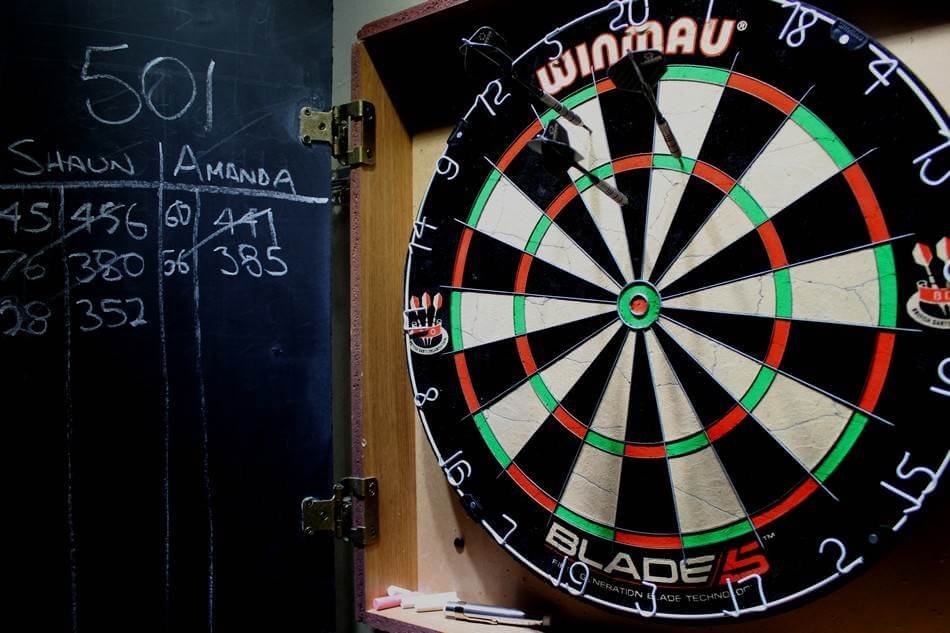Keeping score in darts is not only essential for tracking the progress of a game but also a fundamental skill for every darts player and fan. A darts score keeper ensures the smooth flow of a match, allowing players to focus on their performance without worrying about the math. Whether you’re playing casually or involved in a competitive league, mastering the art of accurate and efficient scorekeeping can significantly enhance the experience. In this guide, we will walk you through essential tips and techniques for scoring in darts, from the basics to advanced strategies.
1. Understanding the Basics of Darts Score Keeper job
Before diving into tips for becoming a great scorekeeper, it’s essential to understand how darts scoring works. A standard dartboard consists of 20 numbered segments, with each segment divided into different scoring areas: the outer single, the double ring, the triple ring, and the bullseye.
- Single segments: These are the larger areas of the numbered section. Hitting any of these awards points equal to the number displayed (e.g., hitting the single 20 scores 20 points).
- Double ring: The outer ring, located on the edge of the dartboard, doubles the score of the number hit. For example, hitting the double 20 scores 40 points.
- Triple ring: The narrow inner ring triples the score of the number hit. A dart in the triple 20 scores 60 points, the highest possible score with a single dart.
- Bullseye: The center of the dartboard is divided into two parts: the outer bullseye (25 points) and the inner bullseye (50 points).

2. Common Darts Games and Their Scoring Systems
The rules and scoring will differ slightly depending on the game being played. Here are a few popular darts games and their unique scoring systems:
- 501: The most common game in professional darts. Each player starts with 501 points, and the objective is to reach exactly 0 by subtracting the score of each throw. The game ends when a player hits a double that reduces their score to exactly 0.
- 301: Similar to 501 but starting with 301 points. Often used in shorter matches or casual games.
- Cricket: A tactical game where players aim to close certain numbers (15 through 20, plus the bullseye) by hitting them three times each. Players also score points by hitting closed numbers that their opponent hasn’t closed yet.
Understanding the specific rules of the game being played is the first step toward accurate scorekeeping.
3. Essential Tools for Darts Score Keeper
To ensure accuracy and efficiency, it’s essential to have the right tools for scorekeeping. These tools help you record scores quickly and accurately, so players can focus on their game.
- Scoreboard: Most dartboards come with a scoreboard, usually a chalk or dry-erase board, which allows the scorekeeper to write down each player’s score. For professional matches, an electronic scoreboard is often used to keep everything visible to both players and spectators.
- Marker or Chalk: If you’re using a manual scoreboard, make sure to have a good marker or piece of chalk on hand for quick and clear updates.
- Calculator (Optional): In competitive settings or when the scorekeeper is new to the game, a calculator can be useful to ensure you’re subtracting scores correctly, especially when numbers get tight.
4. Tips for Accurate Scorekeeping
Accuracy is the most critical aspect of being a good scorekeeper. A mistake in keeping score can alter the course of a match, and in competitive environments, errors can cause disputes. Here are a few essential tips to improve accuracy:
a. Practice Mental Math
Scorekeeping in darts requires quick subtraction. For example, in a 501 game, you’ll need to subtract the total points scored on each turn from the starting score. It’s beneficial to practice mental math or have a system in place to quickly calculate scores after each turn. Familiarizing yourself with common numbers, like those resulting from combinations of doubles and triples, will make scorekeeping faster and more accurate.
b. Double-Check Before Writing
Before recording the score on the scoreboard, take a moment to double-check your calculations. This small step can prevent unnecessary confusion or disputes later. If you’re unsure about the math, ask the players or use a calculator to ensure accuracy.
c. Learn Common Darts Checkout Combinations
As players approach the end of a game, knowing the common checkout combinations can help you anticipate the potential scores. For example, when a player is left with 170, you know the possible checkout involves a triple 20, triple 20, and bullseye. Understanding these combinations will help you stay ahead in the scorekeeping process.
d. Stay Focused
Scorekeeping requires concentration, especially in high-stakes games. Avoid distractions by staying focused on the game, watching where each dart lands, and calculating the score promptly. If you lose track of the score, it’s okay to ask players to confirm their last throw before continuing.
5. Tips for Efficient Scorekeeping
Efficiency is just as important as accuracy when it comes to scorekeeping. The faster you can record scores, the smoother the game will run. Here are some tips for improving your efficiency:
a. Use Abbreviations
To keep the game moving, use abbreviations when recording scores. For example, instead of writing “Double 20” or “Triple 19,” simply use “D20” or “T19.” This shorthand will save time and allow you to quickly jot down the score before moving on.
b. Prepare for Each Turn
Pay attention to each player’s score before they take their turn. Knowing the possible checkout or the segment they’re likely aiming for will help you quickly calculate their score as they throw.
c. Keep the Board Clean
A cluttered or unclear scoreboard can slow down the game. Keep the scoreboard neat and organized by erasing old scores as soon as they’re no longer needed. This will help both players and spectators follow the match more easily.
6. Managing High-Pressure Situations as a Darts Score Keeper
During close matches or tournaments, the pressure on the scorekeeper can be intense. In these moments, it’s essential to remain calm and focused. Here’s how to handle high-pressure situations:
- Stay calm: Don’t let the intensity of the game cause you to rush. Take your time with each calculation to ensure accuracy.
- Communicate clearly: If there’s any confusion about a score, communicate clearly with the players to resolve the issue. It’s better to clarify things immediately than to let an error affect the game.
- Remain neutral: As a scorekeeper, it’s essential to remain impartial, especially during competitive matches. Focus solely on keeping accurate scores without showing any favoritism or reacting emotionally to the game.
7. The Role of Technology in Modern Darts Scorekeeping
While traditional scorekeeping methods like chalkboards and manual tallying still dominate casual play, the use of technology in darts is growing. Apps and electronic scoring systems offer a more accurate and efficient way to keep track of scores. These tools automatically update scores based on where darts land and even suggest checkout routes.
- Popular scoring apps: Apps like DartCounter and Darts Scorer Pro help track scores in real-time and are available for both mobile devices and tablets. They also offer practice modes to help players improve their skills by tracking performance over time.
- Benefits: Technology reduces the risk of human error and speeds up the scoring process. In professional matches, electronic systems ensure that scores are updated instantly and displayed on big screens for the audience.
8. Scorekeeper Etiquette
In addition to accuracy and efficiency, a good scorekeeper should also follow proper etiquette. Here are some guidelines to keep in mind:
- Be invisible: While your role is crucial, a good scorekeeper should remain in the background and avoid drawing attention to themselves.
- Respect the players: Ensure you’re not distracting players by making noise or unnecessary movements during their throw.
- Stay consistent: Apply the same level of focus and professionalism to each game, whether it’s a casual match or a high-stakes tournament.
9. Scorekeeping for Different Levels of Play
Scorekeeping can vary depending on the level of play. For example:
- Casual matches: In casual settings, the atmosphere is usually relaxed, and players may not need detailed scorekeeping. A simple chalkboard and a good understanding of the game are often enough.
- League matches and tournaments: In more competitive environments, precision is critical. Scorekeepers must ensure every dart is accounted for accurately and recorded promptly.
10. Common Mistakes and How to Avoid Them
Even the best scorekeepers can make mistakes. Here are a few common pitfalls and how to avoid them:
- Misreading the dartboard: Sometimes, it’s difficult to see exactly where a dart landed. If you’re unsure, ask the players to confirm before marking the score.
- Forgetting the math: Quick mental subtraction can sometimes trip up even experienced scorekeepers. Use a calculator or double-check your math to avoid mistakes.
- Losing track of turns: In busy or fast-paced games, it’s easy to lose track of whose turn it is. Stay focused and attentive to avoid this.
Conclusion as a Darts Score Keeper
Scorekeeping is a vital part of any darts match, ensuring that the game flows smoothly and that all players’ achievements are properly recorded. By practicing mental math, staying focused, and using the right tools and strategies, you can become an efficient and accurate scorekeeper. Whether you’re playing casually with friends or working at a professional tournament, the tips and techniques in this guide will help you manage scoring with confidence.





